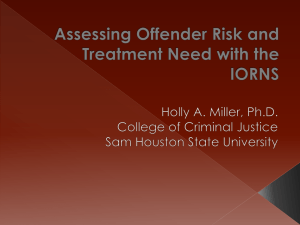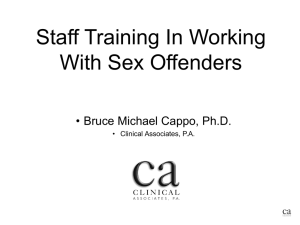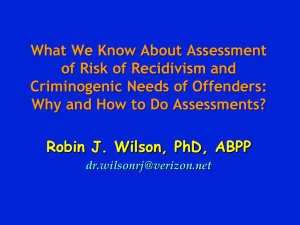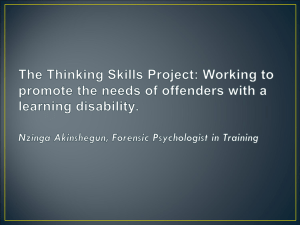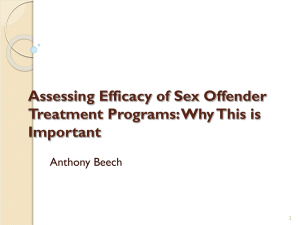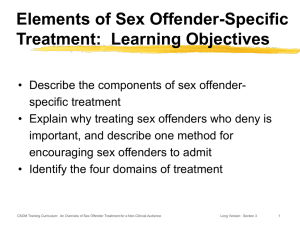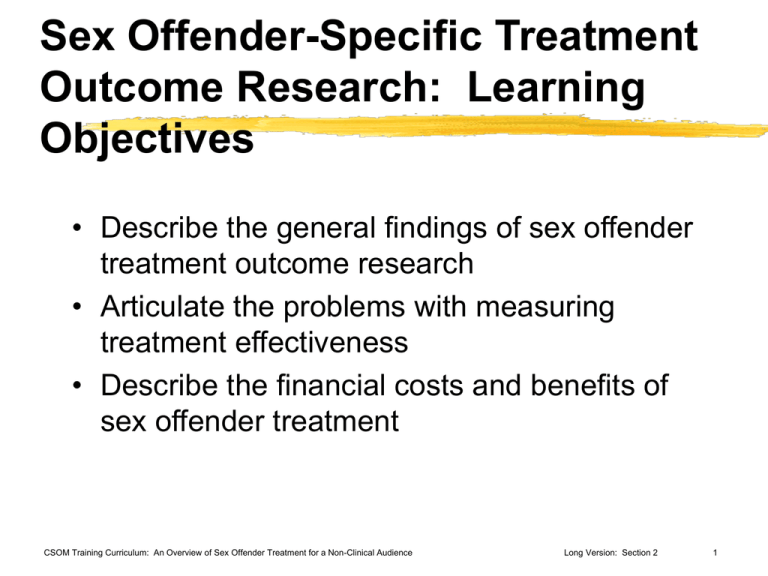
Sex Offender-Specific Treatment
Outcome Research: Learning
Objectives
• Describe the general findings of sex offender
treatment outcome research
• Articulate the problems with measuring
treatment effectiveness
• Describe the financial costs and benefits of
sex offender treatment
CSOM Training Curriculum: An Overview of Sex Offender Treatment for a Non-Clinical Audience
Long Version: Section 2
1
Does Treatment Reduce
Recidivism in Sex Offenders?
• Goal: to protect the community by reducing
the likelihood of future sexual assaults
CSOM Training Curriculum: An Overview of Sex Offender Treatment for a Non-Clinical Audience
Long Version: Section 2
2
Problems with Measurement of
Treatment Effectiveness
• Variations (sometimes extreme) in recidivism
rates between different programs
• Typically low recidivism rates make finding
statistically significant results very difficult
• Issue of base rates for measuring recidivism
in treatment outcome studies
• Because base rates for sexual reoffending fall between 10%
and 25% in most studies, and sample sizes typically are
small (fewer than 200 offenders), the treatment effect must be
very large (greater than 50%) to observe significant
differences between treated and untreated offenders
CSOM Training Curriculum: An Overview of Sex Offender Treatment for a Non-Clinical Audience
Long Version: Section 2
3
Hanson & Morton-Bourgon, 2004
• Update of 1998 meta-analytic review of sex
offender recidivism studies
• Analyzed 95 studies containing 31,216 sex
offenders
• This study examined primarily dynamic
(changeable) risk factors, rather than the static
(unchangeable) factors reviewed in the 1998
study
• 5-6 year follow-up
CSOM Training Curriculum: An Overview of Sex Offender Treatment for a Non-Clinical Audience
Long Version: Section 2
4
Hanson & Morton-Bourgon, 2004
(cont.)
• Results showed that the sexual recidivism rate across
all studies was 13.7%
• General recidivism rate was 36.9%
• All types of recidivism were predicted by offenders
having an unstable, antisocial lifestyle, or lack of selfcontrol
• Those individuals with deviant sexual interests,
particularly in children, were most likely to reoffend
sexually
• High rates of sexual preoccupation were significantly
related to all forms of recidivism
CSOM Training Curriculum: An Overview of Sex Offender Treatment for a Non-Clinical Audience
Long Version: Section 2
5
Lösel & Schmucker, 2005
• First international meta-analysis of both published and
unpublished sex offender biological and psychological
treatment outcome studies
• Included 69 studies with more than 22,000 subjects
were analyzed—about one-third published since the
year 2000 and one-third published outside North
America
• Recidivism was operationalized as broadly as
possible, ranging from incarceration to lapses in
behavior
CSOM Training Curriculum: An Overview of Sex Offender Treatment for a Non-Clinical Audience
Long Version: Section 2
6
Lösel & Schmucker, 2005 (cont.)
• 11% recidivism rate in treatment groups
• 17.5% recidivism rate in control groups
• Overall, treatment provides a 37% reduction in
sexual recidivism
• Cognitive-behavioral treatments had the most
significant impact on sexual recidivism
CSOM Training Curriculum: An Overview of Sex Offender Treatment for a Non-Clinical Audience
Long Version: Section 2
7
Lösel & Schmucker, 2005 (cont.)
Lösel & Schmucker, 2005
20%
17.5%
18%
16%
14%
12%
11%
10%
8%
6%
4%
2%
0%
Treatment Groups
CSOM Training Curriculum: An Overview of Sex Offender Treatment for a Non-Clinical Audience
Control Groups
Long Version: Section 2
8
Marques et al., 2005
• Marques and colleagues employed an experimental
design to evaluate the Sex Offender Treatment and
Evaluation Project (SOTEP)
• Stationed at Atascadero State Hospital in California,
SOTEP operated from 1985 to June 1995
• Randomized clinical trial
• 704 participants
• 259 = relapse prevention program
• 225 = untreated volunteer control
• 220 = untreated non-volunteer control
• 8 year follow-up
CSOM Training Curriculum: An Overview of Sex Offender Treatment for a Non-Clinical Audience
Long Version: Section 2
9
Marques et al., 2005 (cont.)
• Final results revealed no significant differences among
the three groups in their rates of sexual or violent
reoffending
• 22% of the treatment group committed a subsequent
sexual offense and 16.2% had a violent reoffense
• 20% of the volunteer group reoffended sexually and
16.3% had a subsequent violent offense
• 19.1% of the non-volunteer control group had a sexual
reoffense and 15% had a violent reoffense
• However, those who did well in treatment recidivated
at lower rates than those who did not progress in
treatment
CSOM Training Curriculum: An Overview of Sex Offender Treatment for a Non-Clinical Audience
Long Version: Section 2
10
Marques et al., 2005 (cont.)
Marques et al., 2005
25%
Sexual
22%
Violent
20%
19%
20%
16%
16%
15%
15%
10%
5%
0%
Treatment Group
Volunteer Control
Non-Volunteer Control
Treatment Group
CSOM Training Curriculum: An Overview of Sex Offender Treatment for a Non-Clinical Audience
Long Version: Section 2
11
McGrath et al., 2003
• Evaluation of a prison-based cognitivebehavioral, relapse prevention treatment
program for adult sex offenders in the State of
Vermont, which included a community
aftercare component
• 195 participants
• 90 = no treatment
• 56 = completed treatment
• 49 = some treatment
• 6 year follow-up
CSOM Training Curriculum: An Overview of Sex Offender Treatment for a Non-Clinical Audience
Long Version: Section 2
12
McGrath et al., 2003 (cont.)
• Results showed that almost one quarter of the total
sample (23%) were found to have committed a new
sex offense during the follow-up period
• Sex offenders in the completed treatment group had a
significantly lower sexual recidivism rate (5%) that
both the some treatment group (31%) and the
no-treatment group (30%)
• The completed treatment group also had a
significantly lower rate of violent recidivism than the
no-treatment group
CSOM Training Curriculum: An Overview of Sex Offender Treatment for a Non-Clinical Audience
Long Version: Section 2
13
McGrath et al., 2003 (cont.)
McGrath et al., 2003
35%
31%
30%
30%
25%
20%
15%
10%
5%
5%
0%
Completed Treatment
No Treatment
Some Treatment
Treatment Group
CSOM Training Curriculum: An Overview of Sex Offender Treatment for a Non-Clinical Audience
Long Version: Section 2
14
Seager et al., 2004
• Seager et al. examined men over the age of
18 who were convicted of a sex offense and
were offered the opportunity to participate in a
manualized treatment program, in which
offender progress was clinically evaluated
• 177 participants
•
•
•
•
81 successfully completed the treatment program
28 were unsuccessful
17 offenders dropped out
19 refused to participate
CSOM Training Curriculum: An Overview of Sex Offender Treatment for a Non-Clinical Audience
Long Version: Section 2
15
Seager et al., 2004 (cont.)
• Overall, 12% of the offenders in this study were
reconvicted for a sex or violent offense and 23% were
charged with a new sex or violent offense
• 4% of successful treatment completers and 7% of
unsuccessful treatment completers were convicted for
a new sexual or violent offense
• 32% of those who dropped out, refused, or were
terminated from treatment incurred a new conviction
and 49% had new charges
• Dropping out, refusing, or being terminated from
treatment was related to higher risk for sexual and/or
violent offending
CSOM Training Curriculum: An Overview of Sex Offender Treatment for a Non-Clinical Audience
Long Version: Section 2
16
Seager et al., 2004 (cont.)
Seager et al., 2004
35%
32%
30%
25%
20%
15%
10%
5%
7%
4%
0%
Successful Treatment
Completion
Unsuccessful Treatment
Completion
Drop-out, Refused, Terminated
Treatment Group
CSOM Training Curriculum: An Overview of Sex Offender Treatment for a Non-Clinical Audience
Long Version: Section 2
17
Problems with Measurement of
Treatment Effectiveness (cont.)
•
•
•
•
•
•
•
Differences in laws, policies about sex offending
Difficulty in following subjects who move
Different sex offender populations
Duration of follow-up
Attrition of sample subjects
Definitions of what constitutes reoffense
Differences in treatment program intensity,
location (prison, community), and methods
CSOM Training Curriculum: An Overview of Sex Offender Treatment for a Non-Clinical Audience
Long Version: Section 2
18
Barbaree and Marshall, 1988
• 126 treated (cognitive-behavioral methods) and
untreated child molesters in a community
sample
• 4 year follow-up
• Recidivism (measured by official police records
and unofficial police and child protective agency
reports) rates quite different between the
treated and untreated groups
CSOM Training Curriculum: An Overview of Sex Offender Treatment for a Non-Clinical Audience
Long Version: Section 2
19
Barbaree and Marshall, 1988
(cont.)
• Extra-familial female-target child molesters
• Recidivism rates over four years for treated
group: 18%; for untreated group: 43%
• Extra-familial male-target child molesters
• Recidivism rates for treated group: 13%; for
untreated group: 43%
• Incest female-target child molesters
• Recidivism rates for treated group: 8%; for
untreated group: 22%
CSOM Training Curriculum: An Overview of Sex Offender Treatment for a Non-Clinical Audience
Long Version: Section 2
20
Barbaree and Marshall, 1988
(cont.)
50%
43%
45%
43%
40%
Treated Group
35%
Untreated Group
30%
25%
20%
22%
18%
13%
15%
8%
10%
5%
0%
Extra-familial female-target
child molesters
Extra-familial male-target child
molesters
Incest female-target child
molesters
Recidivism Rates
CSOM Training Curriculum: An Overview of Sex Offender Treatment for a Non-Clinical Audience
Long Version: Section 2
21
Rice, Quinsey, and Harris, 1991
• Studied 136 extrafamilial child molesters from
a maximum security psychiatric hospital over
a 6 year follow-up period
• Found no treatment effect
CSOM Training Curriculum: An Overview of Sex Offender Treatment for a Non-Clinical Audience
Long Version: Section 2
22
Hall, 1995
• Performed meta-analysis on 12 sex offender
treatment outcome studies
• Total sample size of 1,313 sex offenders
• Recidivism: formal legal charge for a new sex
offense after the completion of treatment for
the treatment group
• Mean length of treatment 18.5 months
CSOM Training Curriculum: An Overview of Sex Offender Treatment for a Non-Clinical Audience
Long Version: Section 2
23
Hall, 1995 (cont.)
• Mean follow-up period across studies was 6.85
years
• Found small but significant recidivism-reducing
treatment effect for treatment versus notreatment or comparison treatment conditions
• Overall recidivism rate for treated sex
offenders: 19%
• Recidivism rate for untreated group: 27%
CSOM Training Curriculum: An Overview of Sex Offender Treatment for a Non-Clinical Audience
Long Version: Section 2
24
Hall, 1995 (cont.)
40%
35%
Treated Group
Untreated Group
30%
27%
25%
20%
19%
15%
10%
5%
0%
Recidivism Rate
CSOM Training Curriculum: An Overview of Sex Offender Treatment for a Non-Clinical Audience
Long Version: Section 2
25
Hall, 1995 (cont.)
• Greatest treatment effects were in studies with
• Longer follow-up periods
• Higher base rates of recidivism
• Outpatient services
• Cognitive-behavioral treatment or antiandrogen treatment
CSOM Training Curriculum: An Overview of Sex Offender Treatment for a Non-Clinical Audience
Long Version: Section 2
26
General Accounting Office, 1996
• Summarized 22 reviews of research on sex
offender treatment covering 550 studies
between 1977 and 1996
• Report concluded that the results are
promising but inconclusive
CSOM Training Curriculum: An Overview of Sex Offender Treatment for a Non-Clinical Audience
Long Version: Section 2
27
Alexander, 1999
• Examined data from 79 sex offender treatment
outcome studies encompassing 10,988
subjects
• Divided offenders and offenses into subtypes
by age of offender, age of victim, offense type,
type of treatment, location of treatment, years
in which treatment occurred, and length of
follow-up
• Recidivism typically defined as subjects who
were rearrested for a new sex offense
CSOM Training Curriculum: An Overview of Sex Offender Treatment for a Non-Clinical Audience
Long Version: Section 2
28
Alexander, 1999 (cont.)
• Offenders who participated in relapse
prevention treatment programs had a rearrest
rate of 7% compared to 18% for untreated
offenders
• 528 adult male rapists: 20% of the treated
group reoffended; 24% of the untreated group
CSOM Training Curriculum: An Overview of Sex Offender Treatment for a Non-Clinical Audience
Long Version: Section 2
29
Alexander, 1999 (cont.)
30%
Offenders who participated in Relapse Prevention Treatment
25%
Untreated offenders
20%
18%
15%
10%
7%
5%
0%
Recidivism Rate
CSOM Training Curriculum: An Overview of Sex Offender Treatment for a Non-Clinical Audience
Long Version: Section 2
30
Alexander, 1999 (cont.)
35%
Treated Group
30%
Untreated Group
24%
25%
20%
20%
15%
10%
5%
0%
Adult Male Rapists
Recidivism Rate
CSOM Training Curriculum: An Overview of Sex Offender Treatment for a Non-Clinical Audience
Long Version: Section 2
31
Alexander, 1999 (cont.)
• 2,137 child molesters: 14% of the treated group
reoffended; 26% of the untreated group
• Treatment effect was especially strong for the
331 exhibitionists: 20% of the treated group
reoffended; 57% of the untreated group
• For all 10,988 study subjects combined, 13% of
the treated group reoffended; 18% of the
untreated subjects reoffended
CSOM Training Curriculum: An Overview of Sex Offender Treatment for a Non-Clinical Audience
Long Version: Section 2
32
Alexander, 1999 (cont.)
70%
60%
57%
Treated Group
Untreated Group
50%
40%
30%
26%
20%
20%
14%
18%
13%
10%
0%
Child Molesters
Exhibitionists
All Study Subjects
Recidivism Rates
CSOM Training Curriculum: An Overview of Sex Offender Treatment for a Non-Clinical Audience
Long Version: Section 2
33
Hanson et al., 2002
The 2002 ATSA Report on the Effectiveness of
Treatment for Sexual Offenders
Collaborative research project to:
• Define standards for research on treatment
outcomes for sex offenders
• Summarize existing research
• Promote high quality evaluations
CSOM Training Curriculum: An Overview of Sex Offender Treatment for a Non-Clinical Audience
Long Version: Section 2
34
Hanson et al., 2002 (cont.)
45%
39%
40%
Treatment Group
35%
Control Group
28%
30%
25%
20%
15%
17%
12%
10%
5%
0%
Sexual Recidivism
CSOM Training Curriculum: An Overview of Sex Offender Treatment for a Non-Clinical Audience
General Recidivism
Long Version: Section 2
35
Seto and Barbaree, 1999
• Evaluated the relationship of clinical ratings of
treatment behavior to recidivism (in-session
behavior, homework quality, motivation and
change achieved)
• Found good treatment behavior was unrelated
to general recidivism but associated with higher
serious violent or sexual recidivism
• Men who scored higher in psychopathy and
better in treatment behavior were the most likely
to reoffend
CSOM Training Curriculum: An Overview of Sex Offender Treatment for a Non-Clinical Audience
Long Version: Section 2
36
Psychopathy
Serious Sex Offender Recidivism
Related to Treatment Behavior
and Psychopathy
Recidivism Rates
High
20.4%
3.6%
Low
5.0%
2.0%
Good
Poor
Treatment Behavior
Seto and Barbaree, 1999
CSOM Training Curriculum: An Overview of Sex Offender Treatment for a Non-Clinical Audience
Long Version: Section 2
37
Financial Costs/Benefits of
Treatment
• Any reduction in recidivism is significant in terms of
reduction of harm to victims and costs to society
• In tangible financial costs, Prentky and Burgess
(1990) estimated the costs per sex offense for
offender-related and victim-related expenses totaled
$183,333
• Therefore, if there are eight fewer offenses for every
100 sex offenders, the tangible financial savings is
$1,466,664
• If we think treatment of sex offenders is expensive,
compare it to the cost of not treating sex offenders
CSOM Training Curriculum: An Overview of Sex Offender Treatment for a Non-Clinical Audience
Long Version: Section 2
38
Summary
• Early evaluations of sex offenders programs found no
evidence that treatment works
• The most recent, largest scale, and best designed
treatment outcome study to date found that treatment
works
• When all studies are reviewed, sex offender
treatment reduces sexual recidivism in adult males
about 5 to 10%
• Any reduction in reoffense rates can result in very
significant cost savings and—more critically—a
reduction in harm
CSOM Training Curriculum: An Overview of Sex Offender Treatment for a Non-Clinical Audience
Long Version: Section 2
39

